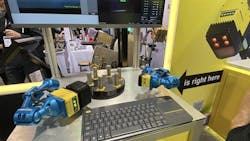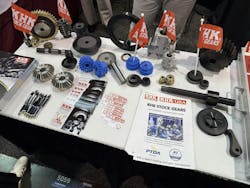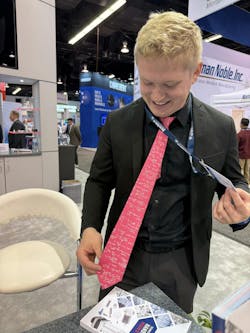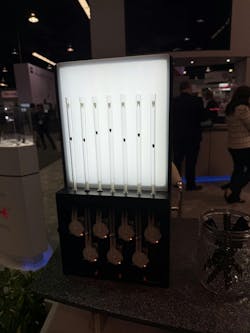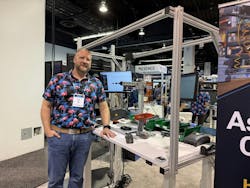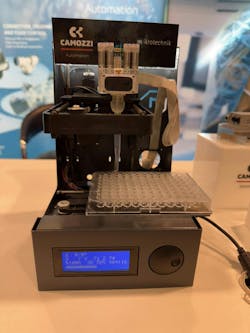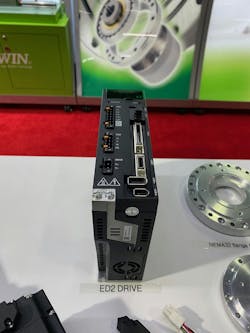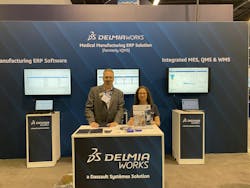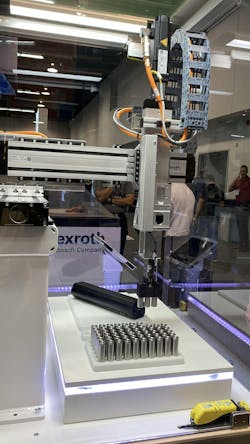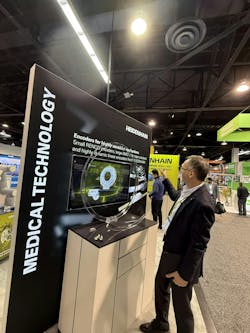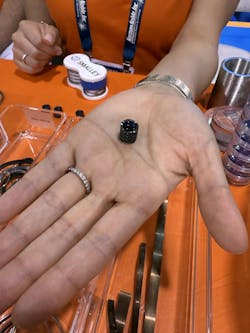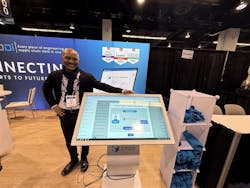Attendees at MD&M West experienced a showcase of innovations that aim to redefine the industry landscape. Trade shows are essential for fostering connections and providing insights into emerging trends and technologies that shape the future of manufacturing, but Machine Design recognizes that not everyone can get to these valuable events. So allow us to bring a few of these technologies to you.
Exhibitors presented a wide array of advancements, including next-generation barcode readers that simplify setup processes through intuitive web-based interfaces, as well as enhanced product catalogs that offer a broader selection of configurations for ready-to-use solutions.
The focus on precision engineering was evident with highlights such as silent, compact pumps designed for medical applications and cutting-edge solenoid valves that emphasize reliability and performance. The commitment to manufacturing integration was highlighted by seamless connections that boost quality assurance, reflecting a growing trend toward custom automation solutions.
Attendees also witnessed advancements in robotic technologies aimed at improving operational efficiency, alongside innovative approaches to procurement that streamline sourcing processes and decision-making. Here is a closer look.
Barcode Reader Technology
Cognex recently introduced the DataMan 290, marking a significant advancement in their next-generation barcode reader technology. Launched at the beginning of the year, Eric Hershberger demonstrated how this new device aids in the setup process by utilizing a web-based user interface (UI). Users no longer need to install any software to set up the DataMan 290; instead, they can easily configure the reader through a series of web pages, Hershberger explained. This highly configurable setup process significantly simplifies the user experience, allowing quick plug-and-play functionality.
While the traditional setup tool remains available for use with other Cognex barcode readers, the web UI is the standout feature of the DataMan 290, enabling a seamless, user-friendly experience from the get-go. Ultimately, the focus is on efficiency and ease of use, allowing users to start reading barcodes with minimal hassle.
Expanding Gear Catalog
Brian Dengel from KHK revealed plans for a 2025 expanded catalog with 27,000 configurations, up from 26,000 this past year. This expansion primarily enhances existing products which are now available with heat treating options for customers seeking ready-to-use solutions. The new catalog will include several innovative sub-series, each designed to address specific customer needs:
J Series. Allows customers to purchase stock items off the shelf, with options for bore opening, keyway insertion and tap tooling.
H Series. Newly introduced, this series provides heat-treated teeth on stock items, enhancing durability and performance for a variety of applications.
HJ Series. A combination of the J and H series, this option allows customers to obtain stock items with optimized bore openings, keyways, tap tooling and heat treatment.
E Series. Featuring eccentric bushings, this series modifies stock items by boring them out and integrating a specialized bushing to meet custom requirements.
F Series. Similar to the E Series, the F Series provides concentric bushings, enabling adjustments to stock gears through strategic bore openings and bushing enhancements.
S Series. This semi-standard series caters to larger products that may not be practical for advance production, allowing customers to order on a major basis.
With a base of 6,000 parts coupled with these diverse sub-series, KHK now boasts 27,000 SKUs in their catalog. While the full line comprises around 32,000 SKUs, it’s noteworthy that 5,000 items had previously been discontinued due to slow movement. Dengel noted, however, approximately 3,800 of those can still be produced if needed.
Valves and Pumps for Precision
The Lee Company showcased an array of products from the company’s Health and Science division. The exhibition focused on cutting-edge solenoid valves and pumps, showcasing its commitment to precision and performance in medical applications. Chris Marchant highlighted the newly acquired piezoelectric disc pump from Leventis. This pump distinguishes itself by being incredibly silent, pulsatile-free and compact, making it an ideal choice for a variety of medical uses.
Marchant pointed out its miniaturization capabilities and high performance, which are critical in today's healthcare landscape. In addition to the disc pump, the Lee Company showcased a range of other pumps, including solenoid-driven dispense pumps and stepper motor-driven variable volume pumps. These products are used for diagnostic instruments requiring high precision and accuracy, with options for customizations to meet specific application needs.
From a valve perspective, the company presented various types, including isolation solenoid valves designed for handling aggressive chemicals. Marchant said these valves are necessary for controlling fluid flow in a reliable manner, whether through two-way or three-way configurations. He also noted the company’s dispensing valves, which are capable of delivering droplets in the nanometer range.
Fun Fact: There’s a story behind the tie that Grant Midkiff donned at Tuesday’s show. When the company’s founder, Leighton Lee II, was coming up with how to calculate a restriction for fluids in a unique way to have more of a set standard, he came up with the Lohm rate, which stands for liquid ohms and is unique to The Lee Company. The tie has Lee’s handwriting from the calculations on it. “We call it the Lee Company tie,” Midkiff told Machine Design. It’s a conversation-starter among employees and clients alike, he said, noting he sometimes gets asked if he is a math teacher when he wears it.
Manufacturing Integration
Pico MES showcased an innovative approach to manufacturing integration, emphasizing seamless connections and robust quality assurance. Their booth showcased and array of integrating devices, from simple input/output device connections like foot switches and badge readers to advanced data-driven tools.
READ MORE: Lean into the Blur of Chaotic Change
Bryan Bauw told Machine Design that one of the key highlights is the company's commitment to ease of use. By focusing on plug-and-play integrations, Pico MES eliminates the need for extensive coding, making it accessible for users to incorporate essential devices into their systems effortlessly. He said this foundational layer paves the way for more sophisticated capabilities, such as partnerships with notable entities like IR and their distributor, Zemarc, which enhance torque management for assembly processes. For instance, when assembling complex products like genomic sequencing machines, Bauw said Pico MES facilitates detailed feedback on the assembly process, allowing manufacturers to monitor and optimize operations in real-time.
When asked about feedback from design engineers, Bauw said that many have expressed interest in how Pico MES can bridge their CAD designs with shop floor data. The integration possibilities are vast, whether through middleware developed by Pico or direct API communication, depending on the existing systems' compatibility. This interconnectedness allows for real-time feedback from operators. For example, if an issue arises—such as a part being too tight—operators can document their observations directly linked to the part's serial number, Bauw said. This feedback can be escalated to both manufacturing and design engineers, driving continuous improvement in parts design and manufacturing processes.
Custom Integration
Camozzi Automation presented its latest capabilities in custom integration solutions aimed at enhancing equipment performance for medical applications. Doug Lenihan showed Machine Design a display that featured a highly specialized piezo pump, originally manufactured by Bartles, which had been modified by Camozzi’s engineering team. The team’s expertise culminated in the development of an advanced aspiration and dispense section, precisely crafted with the integration of solenoid valves, a manifold block and a custom-designed printed circuit board (PCB).
Advancements in Robotics
HIWIN displayed their advancements in harmonic drive systems and strain wave bearings. These components are integral to the performance of articulated and humanoid robots. Joe Jou showed Machine Design the company’s harmonic drives, commonly known as strain wave bearings, and said they offer significant advantages in various applications, including medical robotics and aerospace. He noted their application in robotic joints, which require high precision and load-bearing capabilities.
One of their standout features is their vertical integration in manufacturing. When needed, they pour their own steel to meet strict quality control standards. This approach not only ensures the desired hardness and heat treatment but also allows for competitive pricing without compromising on quality, Jou said, adding that their process involves working closely with design teams to select the right products, materials and technologies, ensuring a tailored solution that meets the exact requirements of the application.
While HIWIN has had strain wave gears in their product lineup for some time, they are continually expanding their offerings. At the show, they introduced new variations of their strain wave gears and cross roller bearings. Jou said a notable mention was the introduction of the E2 drive, featuring embedded Ethernet IP protocol, which improves the connectivity and functionality of their robotic systems.
Integrated MES
DELMIAWorks, formerly known as IQMS, showcased its solutions for the medical manufacturing sector. An ERP (Enterprise Resource Planning) solution, DELMIAWorks provides integrated manufacturing execution systems (MES) and comprehensive warehouse management capabilities tailored for the unique needs of medical device manufacturers.
One of the standout announcements was the integration of Dassault Systemes’ DELMIAWorks with its SOLIDWORKS, a CAD engineering solution known to many in the industry. DELMIAWorks enables users to begin their workflow with a 3D model, seamlessly transitioning that model into the DELMIAWorks environment through a new feature called Data Bridge. This integration not only streamlines processes but also enhances efficiency and collaboration among engineering teams.
Linear Guides, Automation Integration
At the Bosch Rexroth booth, Clint Hayes showed Machine Design their latest linear technologies, highlighting the company’s evolution from profile rail products to integrated solutions like the Integrated Measuring System (IMS). Hayes said that the company initially focused on linear guide products designed for rigidity and high load capacity. The current offerings combine linear guidance with ball screw and roller screw technologies to achieve precise load handling across various industries, ranging from nanometer-level production to aerospace tooling.
READ MORE: As Seen at MD&M West 2025: Product Showcases, Solutions and More
Hayes said that Rexroth’s collaboration with their automation electrification division enhances their offerings by pairing mechanical components with advanced servo motors, drives and PLCs, creating comprehensive solutions for customers.
The exhibit showcased standard XYZ solutions that incorporate drive and guidance mechanisms housed in precise aluminum extrusions. Hayes noted these systems cater to a diverse range of applications, including battery pick-and-place tasks, as pictured.
Measuring Technology for Patient Treatment
Gisbet Ledvon from Heidenhain showed Machine Design the impact their measuring technology can have on the medical industry. The ability to accurately position patients on treatment tables is a game-changer, he said, adding that with their advanced systems, once a patient is placed correctly for treatment, they can return for subsequent sessions with absolute precision.
“This means that a patient can come back after a week or even two, and the treatment will be delivered exactly to the same spot, ensuring that the tumor is targeted without damaging the surrounding healthy tissue,” Ledvon said. He noted that measurement technology typically associated with robotics and machine tools is finding vital applications in the medical field to help save lives.
Compact Spring
Smalley’s Lauren Nagys told Machine Design that they are preparing to launch a new high-force spring, called a nested crest to crest, designed for aerospace and oil and gas industries. This compact spring offers high force and is made from various materials, including carbon steel, stainless steel and over 40 different alloys, tailored to customer needs. Additionally, the springs can be heat-treated as required. While this nested spring is their latest offering, the company also showcased a range of established products for customers across various industries.
Streamlining the Sourcing Process
Chris Brown from CADDi told Machine Design about how CADDiQuote is developing procurement with its AI-powered solutions designed specifically for managing sourcing events. When a new sourcing event is initiated, he said, the tool automatically searches for all similar parts, analyzing supplier data, historical costs and quality metrics. It then recommends the top three suppliers from the existing procurement database and facilitates the sending of quotes.
READ MORE: Elevating Expertise with MD&M West’s Educational Opportunities
What makes this process efficient, he noted, is the ability for suppliers to enter a dedicated portal, where they provide pricing information. This data is processed by AI-based business intelligence (BI) tools that extract essential information, such as costs, lead times and quality assessments. Ultimately, the system recommends the most suitable supplier for each component. Brown added that what’s particularly beneficial is the integration with ERP systems through APIs, allowing for seamless data transfer. Purchase orders can be automatically generated and sent to the best supplier based on comprehensive analysis, significantly reducing the sourcing time from several hours to just about 35-40 sec., he said.
This speed and efficiency are especially advantageous for engineers in R&D, Brown explained, because typically engineers lack direct access to approved vendor lists or historical quality data, but this solution can alleviate this issue. “It allows engineers to focus on their core tasks without having to navigate the procurement complexities, thereby streamlining the overall sourcing process,” Brown said.
Editor’s note: For more show coverage, be sure to check out our MD&M West 2025 content hub.

